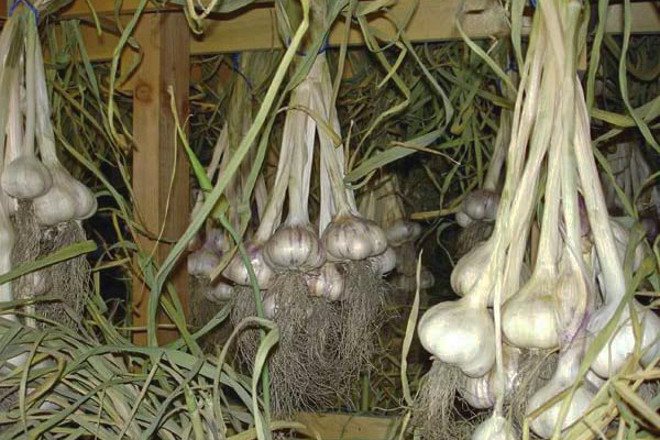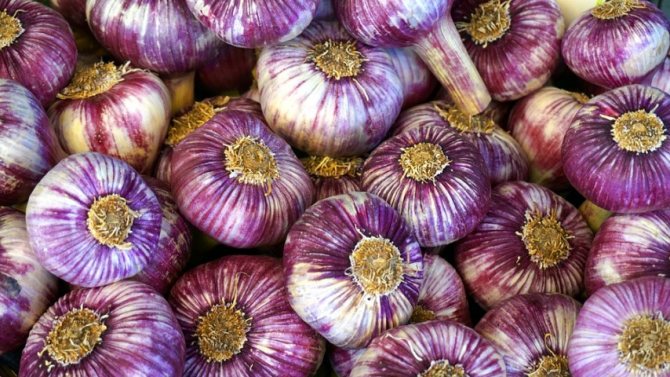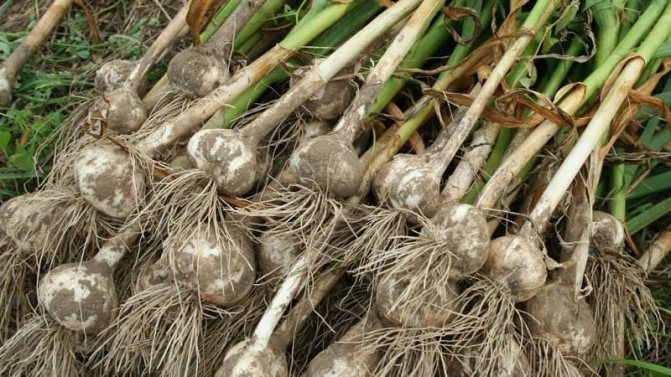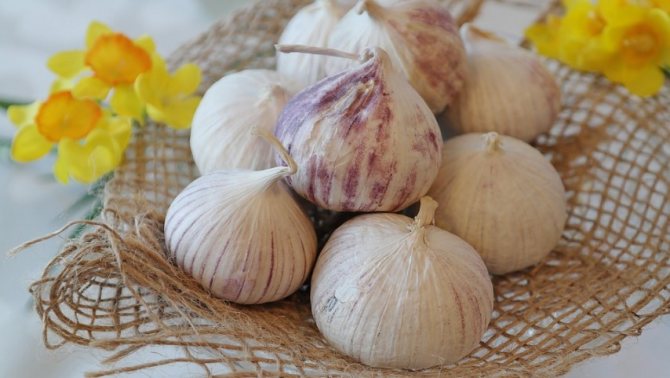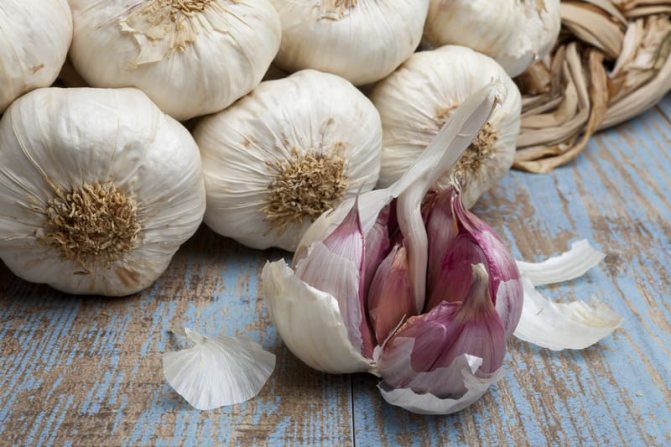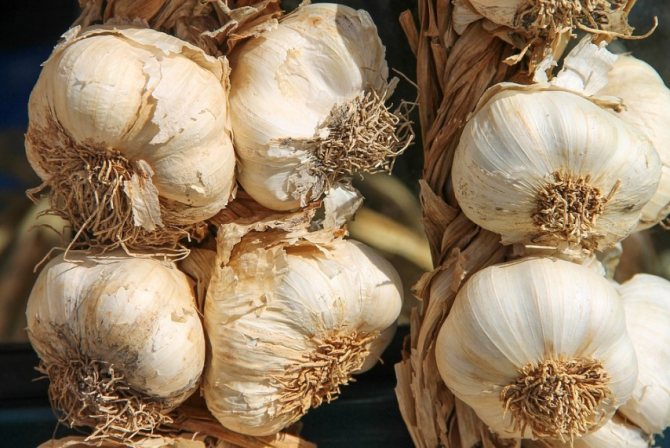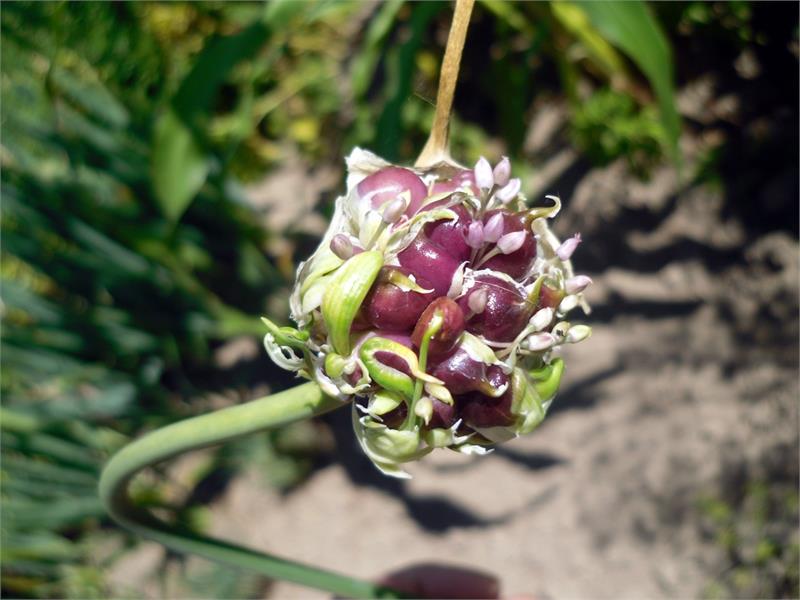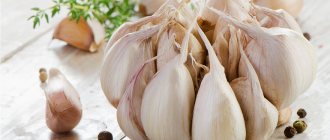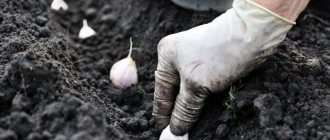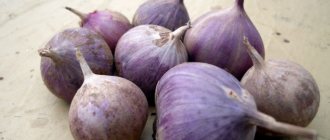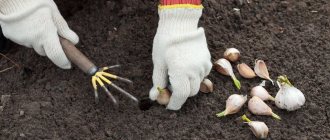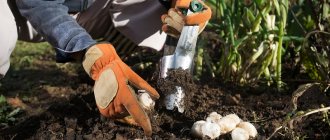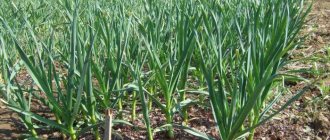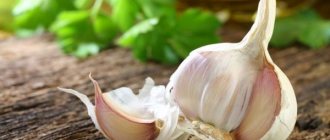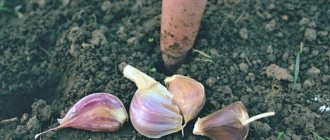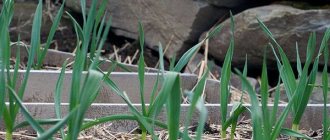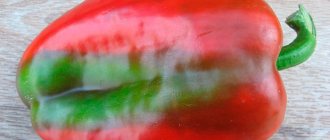Home / Garden / Bulbous
Back to
Published: 10.11.2019
Reading time: 8 min
0
93
Winter garlic, loved by many summer residents, has one drawback - it is poorly stored. But if you dig up the bulbs in time and store them correctly, there will be no problems. How do you know if a vegetable is ripe or not, and when to start harvesting?
- 1 Features of winter garlic
- 2 Approximate cleaning times
- 3 Signs of ripeness of garlic
- 4 Harvesting
- 5 Preparation for storage
When to harvest winter garlic (planted before winter)
So, when is it better to harvest winter garlic, in what month? On average, the procedure is performed in the second half of July and early August... However, it is difficult to name the exact time of the procedure, because there are different varieties of crops (early ripening, late ripening), different growing conditions and weather conditions.
Early-ripening varieties can be dug out in 85-95 days, late-ripening - in 100-110 days.
The ripening rate of the crop also depends on the planting material. When planting single-toothed young heads in autumn, they ripen 20-25 days earlier, after them small teeth ripen, lastly garlic ripens, which was planted with medium and large cloves.
The optimal harvest time for winter garlic planted before winter is determined by the plants themselves:
- The first sign of ripening is that the tips of the leaves turn yellow, the lower leaves dry out. More intense yellowing of leaves indicates the earliest readiness of the crop for harvest.
- Yellowing and dying off of half or more leaves indicates that the plant is ready.
- The arrow with the seeds straightened, the shell of the inflorescence, in which the bulbs are located, started to burst... However, it is recommended to collect before cracking, but the arrow should not be bent.
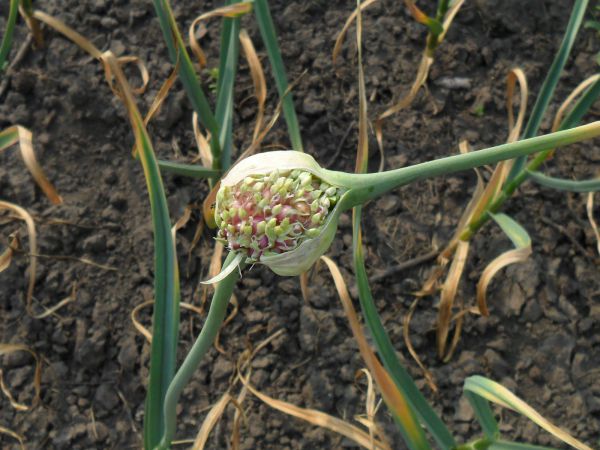
- By the color of the scales you can determine the ripeness of varieties that do not shoot. The garlic is ready in case the upper scales are slightly damaged, rotting away, and the upper ones have acquired a shade that is characteristic of their variety.
By the way! When growing a particular variety of winter garlic, you can dig up one head and tast it to gauge the ripeness. And if this specimen is ripe, it means that others need to be dug up.
It is important to observe the optimal and correct timing for harvesting the garlic crop from the garden, otherwise the garlic bulbs will overripe, begin to crack and disintegrate into slices. Because of this, the storage period is significantly reduced.
As soon as you notice the signs described above on the plants, you need to dig out the crop within five to seven days. Not later!
What is the danger of violating the timing of harvesting garlic
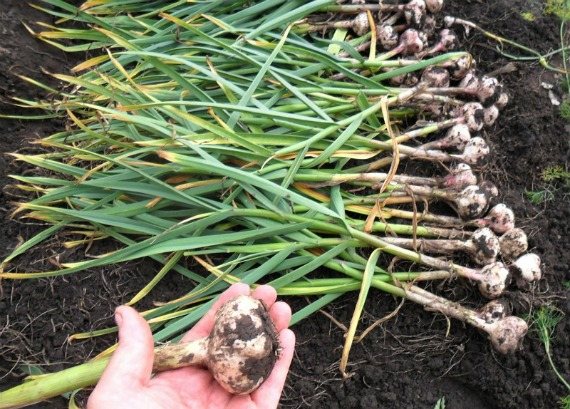

Garlic bulbs overripe quite quickly. If the garlic is not dug up in time, then:
- after 3-5 days, the surface scales are loosened, the teeth are separated from each other, the integrity of the head is violated;
- overripe bulbs begin to grow roots again; during harvesting, such garlic cannot be removed without damaging the growing roots;
- as a result, the head becomes vulnerable to the penetration of various infections, the keeping quality of the vegetable decreases;
- a significant delay in the timing of harvesting threatens a complete loss of the crop or a significant decrease in its quality and deterioration in taste.
That is why it is important to complete the harvesting work on time. Losing the fruits of your labor is always a shame and you must try to avoid it.
When to harvest spring garlic (planted in spring)
Spring garlic is planted in spring, and winter garlic - before winter, therefore, in the first case, harvesting is done later than in the second.
And when is the best time to harvest? As a rule, gardeners do this. from mid-August to mid-September... Again, the variety, planting time, growing conditions affect the readiness time.
You can determine the most accurate harvest time for spring garlic planted in spring by the appearance of the plants:
- New leaves do not appear or grow.
- The leaves turn yellow.
- The neck of the plant becomes soft, because of this, the stem lodges.
It is very important not to miss the moment and harvest at the right time, otherwise the growth of the root system will continue, and because of this, the keeping quality of the crop will decrease, the shelf life will decrease, and useful properties will deteriorate.
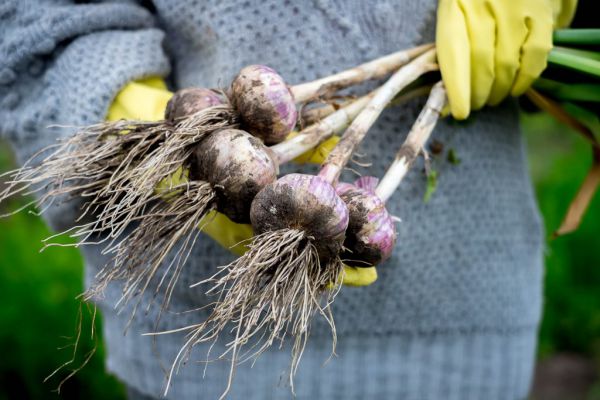

How to choose a digging time depending on the area
Harvesting of garlic in our country begins in July. Winter varieties are dug up this month, and spring varieties are harvested in August.
In a cold or, conversely, too dry and hot summer, the ripening time of garlic is slightly shifted. But usually not much, 5-7 days.
In Belarus
In Belarus, garlic harvesting begins in the second decade of July (usually from the day of Peter and Paul) and continues until the end of the month.
In outskirts of Moscow
In the capital region, winter garlic begins to be dug up in the second decade of July. Harvesting in Tver, Vladimir, Kostroma is similar in terms of timing. Spring varieties begin to be harvested at the end of August. The harvesting campaign continues until mid-September.
In the southern regions
In the Kuban, the Caucasus and the Crimea, garlic is dug out first of all. The harvesting campaign in these regions usually starts at the very beginning of July. And "for food" garlic is dug up here at the end of June.
In Siberia
Beyond the Urals, harvesting of winter varieties begins in the 20th of July. In cold summers, the dates may shift closer to the beginning of August.
In the middle lane
In the regions of Central Russia, winter garlic begins to be harvested on July 8 - 10 and continues to harvest the flesh until the end of the month. The harvesting of spring crops begins in mid-August.
IMPORTANT! If precipitation is predicted for the second half of July, then it is better to hurry up with the harvest. This will save the heads from moisture, which increases the drying time and negatively affects the shelf life.
Collection dates for the lunar calendar 2019
Many summer residents are guided by the cycles of the moon when performing any summer cottage procedures (for example, planting in open ground, sowing seedlings, pruning, watering and many other activities). Harvesting is no exception: experienced gardeners have noticed that if the procedure is performed at the most suitable time, the harvest is stored longer.
Favorable days for harvesting winter and spring garlic according to the lunar calendar 2020:
- July: 5, 6, 7, 15, 16, 19, 20, 23, 24 number;
- August: 1, 2, 3, 11, 12, 15, 16, 29, 30;
- September: 15, 18, 19, 22, 23, 24.
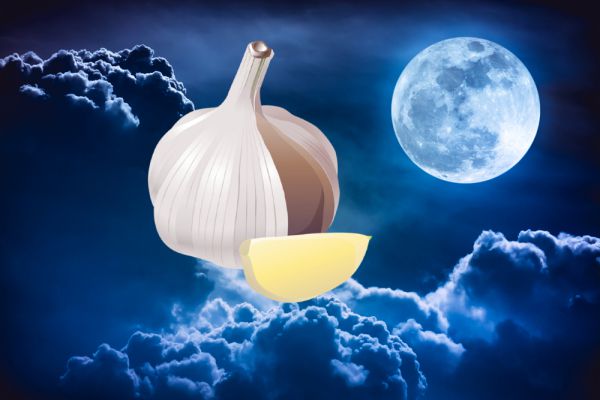

How to prepare your garlic crop for harvest
During the period of active ripening of garlic, it is recommended to carry out some manipulations that will stimulate the ripening of the crop and prepare the plants for harvest:
- A month before harvesting, you should reduce watering, and 10-14 days before digging, completely stop applying moisture to prevent decay of the heads.
- After about a week, you should cut off the leaves, which begin to turn yellow.
- 2-3 days before harvesting, it is recommended to weed and loosen the soil in the plant bed.
- It is necessary to tie the arrow, and then break off. Manipulation is necessary so that the culture does not waste energy and nutrients on the ripening of seeds, but directs them in the right direction, that is, on the ripening of the head.
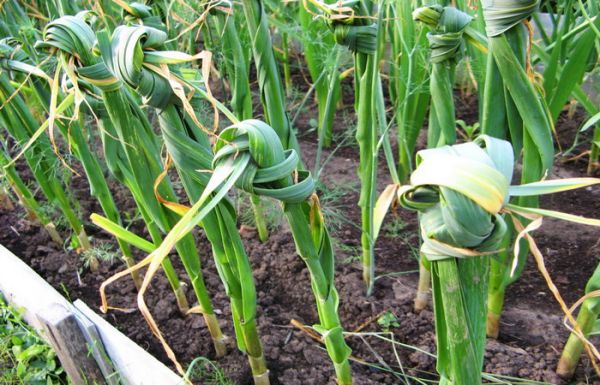

Important! It is recommended to leave a couple of arrows in order to navigate along them, because bursting inflorescences on the arrows indicate the readiness of the crop for harvest.
Storage
If you want to get garlic next year, then you can leave a few plants, wait until a couple of weeks have passed from harvesting and dry them under a canopy. After 30 days, they will take on a different color and burst, but they will be ready for a new planting.
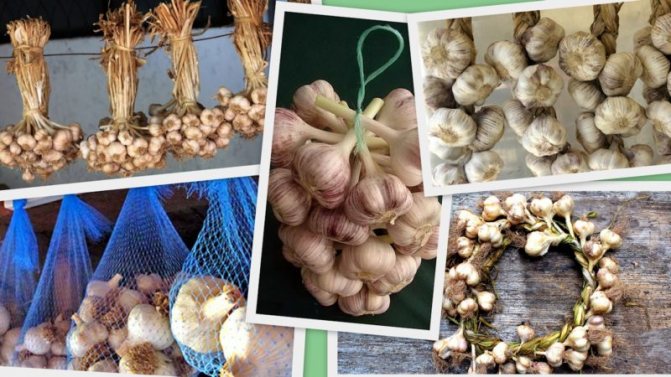

winter garlic storage
Dried garlic should be stored at a temperature of - + 18 degrees. Usually, the house gave it all the conditions, for this you can even tie them in a pigtail and put them in the kitchen. A bag and a box will also work well. But winter garlic stays fresh for about 4 months. If you have cloves left by the time it expires, it's best to use them in the blockage.
205
Author of the publication
offline 2 months
Nika
59
Comments: 0Public: 167Registration: 25-06-2018
How to properly harvest winter and spring garlic
There are no differences between the collection of spring garlic, planted in spring, and winter garlic, planted before winter in autumn, so we will consider the basic rules and schemes of the procedure.
It is best to harvest in the garden in the morning or eveningwhen the sun is not very active. In this case, there should be dry, warm weather... It is not recommended to collect in rainy and humid weather.
To properly and quickly dig the heads of garlic out of the ground, you need to take a shovel or pitchfork and carefully dig under the plant. In this case, the tool must be driven into the ground. at right angles (90 degrees), because if you do it at an angle, you can damage the bulb. And then gently pull out the plant with your hands.
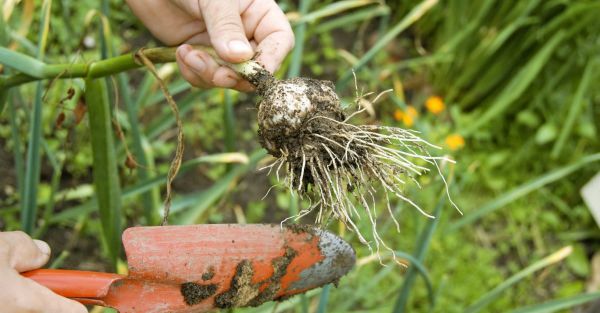

Important! It is highly discouraged to simply pull the bulbs out of the ground without digging. The fact is that with dry ground, the stem is likely to simply come off, and the head will remain in the soil. The best option is to carefully dig it up.
Preparing the garlic crop for storage
Obviously, the keeping quality of the crop depends on the storage conditions: the more suitable and optimal conditions, the longer the heads are stored. But preparing the crop for storage is no less important!
The following tips will help you properly prepare the spring and winter garlic heads for storage in the fall and winter:
- The head must be handled carefully, it must not be damaged, the roots and the bottom, the slightest damage will become the gateway for infections, and the infected specimen cannot be saved.
- To eliminate excess soil on the head, you should carefully remove the soil with your hands. If the dirt does not lag behind, then you can very gently knock on your palm and try to remove it again.
- Immediately after digging, the roots and stem (tops) must be left, they do not need to be cut off immediately.
- When the entire crop is dug up, it must be dried until the stem and root system are completely dry. To do this, take the crop to a warm, dry and well-ventilated area. On average, it takes 2-3 weeks to dry. By the way, properly dried heads rustle when sprinkled.
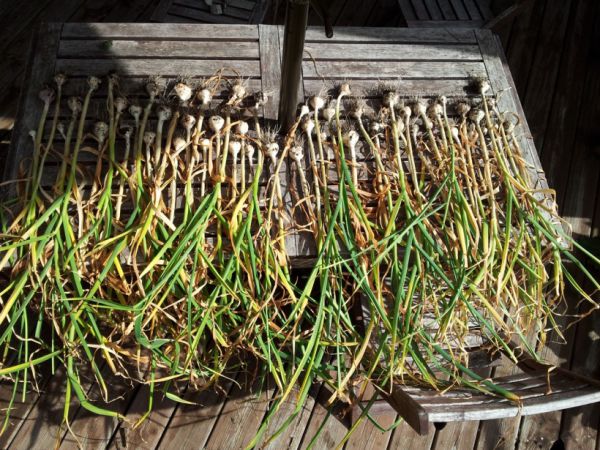

- After the roots and stem are completely dry, you need to cut off the stem (leaving a stump about 5-7 centimeters) and roots (leaving somewhere one or two centimeters).
- You need to carefully examine the harvest. Damaged copies cannot be sent for storage, they are still likely to undergo infections and will not be able to lie for a long time.
Note! If you want to store the garlic in a braid shape, you don't need to trim the tops!
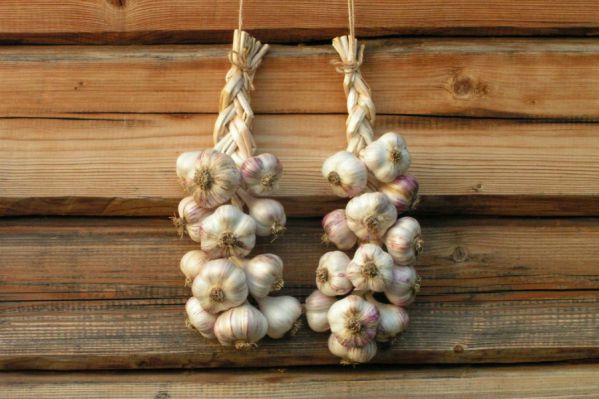

How to store it correctly
Proper storage of the harvested garlic crop allows you to extend its keeping quality and not lose its presentation. Storage conditions:
- Keeping in a ventilated room with a temperature of + 2-4 ° C. If kept at higher temperatures, the shelf life is reduced, since the garlic heads gradually begin to dry out;
- Maintaining a certain level of humidity in the room. This factor significantly affects the safety of the garlic harvest. The vegetable is best preserved if the moisture indicator is kept at 60-80%. Keeping garlic in a drier room can cause the heads to lose their freshness - they dry out quickly.On the contrary, too high humidity provokes the development of fungal pathogens, infecting the stored crop with them;
- Organization of ventilation, with the help of which it is possible to regulate air humidity and temperature conditions.
Depending on the volume of the harvest, garlic can be stored in bulk in well-ventilated containers - in nets, baskets and boxes. In addition, it is perfectly stored in a suspended state, being previously braided into wreaths and braids, gathered in bunches.
Attention! Before storage, the leaves are removed from the dried garlic, the tails are trimmed. Removing them earlier - before the garlic dries out, is not recommended.
